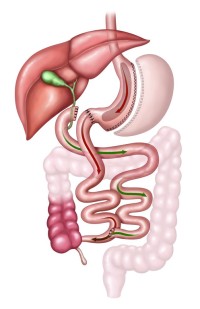Laparoscopic Bilio Pancreatic Diversion with duodenal switch
The BPD-DS procedure includes a vertical sleeve gastrectomy, which reduces the stomach along the lesser curve of the stomach, effectively restricting its capacity thereby limiting food intake. In addition due to the removal of a large percentage of the stomach, it was been shown that certain levels of hunger hormones are reduced which limits a patients desire/drive to eat. The malabsorptive component of the BPD/DS procedure rearranges the small intestine to separate the flow of food from the flow of bile and pancreatic juices much like the gastric bypass. However, unlike the gastric bypass the divided intestinal paths are rejoined much further down stream (common channel is much shorter than the gastric bypass) which results is significantly more malabsorption then the gastric bypass.










